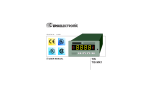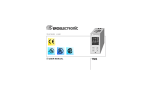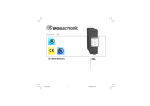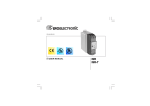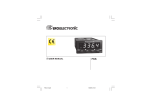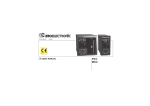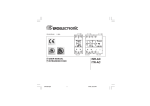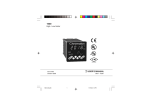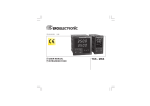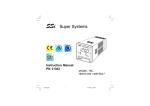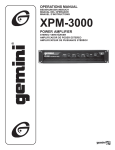Download r USER MANUAL - E
Transcript
170.IU0.LHI.0A0 r USER MANUAL LHI INDEX MOUNTING REQUIREMENTS .............................. 1 DIMENSIONS AND REAR TERMINALS ................ 2 PANEL CUT OUT ................................................. 3 WIRING GUIDELINES ......................................... 3 PRELIMINARY HARDWARE SETTINGS .............. 8 CONFIGURATION PROCEDURE .......................... 9 OPERATING MODE ........................................... 14 Normal display mode .................................. 14 Indicators ................................................... 14 Key functions in normal display mode ....... 14 Operative parameter display mode ............ 15 Key functions in operative parameter display mode ............. 15 Operating parameters ................................ 16 Peak detections ......................................... 16 Alarm functions .......................................... 17 Serial link ................................................... 17 ERROR MESSAGES .......................................... 18 GENERAL SPECIFICATIONS ............................ 19 MAINTENANCE .................................................. 22 DEFAULT PARAMETERS .................................. A.1 APPENDIX B .................................................... B.1 MOUNTING REQUIREMENTS Select a mounting location with the following characteristics: 1) Minimal vibration. 2) An ambient temperature range between 0 and 50°C (32 and 122 °F). 3) Easy access to the rear of the instrument. 4) No corrosive gases (sulfuric gas, ammonia, etc.). 5) No water or other fluid (i.e. condensation). 6) Relative humidity of 20% to 85% non condensing. The instrument can be mounted on a panel up to 15 mm (0.591 in) thick with a square cutout of 45 x 45 mm (1.772 x 1.772 in). For outline refer to Dimensions and Panel Cutout. The instrument is shipped with a rubber panel gasket (50 to 60 Sh). To insure the IP65 and NEMA 4 protection, insert the panel gasket between the instrument and the panel as shown below. Install the instrument as follows: 1) Insert the instrument in the gasket. 2) Insert the instrument in the panel cutout. 3) Pushing the instrument against the panel, insert the mounting bracket. 4) Torque the mounting bracket screws between 0.3 and 0.4 Nm (2.66 and 3.54 lbf-in). 5) To insure NEMA 4X/IP65 protection, make sure the instrument does not move within the cutout . Panel surface texture must be better than 6.3 µmm. bracket Screw Fig. 1 Panel Gasket DIMENSIONS AND REAR TERMINAL BLOCKS Without RS-485 With RS-485 Fig.2 GB 2 PANEL CUTOUT WIRING GUIDELINES A) Measuring Inputs NOTE: Any external components (like Zener diodes, etc.) connected between sensor and input terminals may cause errors in measurement due to excessive and/or not balanced line resistance or possible leakage currents. TC Input + 10 _ 9 Shield + 10 Fig.3 _ 9 Shield Fig. 4 THERMOCOUPLE INPUT WIRING NOTE: 1) Do not run input wires with power cables. 2) For TC wiring use proper compensating cable, preferably shielded (see Appendix B). 3) Shielded cable should be grounded at one end only. GB 3 LINEAR INPUT RTD INPUT RTD RTD 10 9 + _ mA, mV or V Shield 8 9 10 8 9 10 10 9 + _ Fig. 5 RTD INPUT WIRING mA mV or V G NOTE: 1) Don’t run input wires together with power cables. 2) Pay attention to the line resistance; a high line resistance may cause measurement errors. 3) When shielded cable is used, it should be grounded at one side only to avoid ground loop currents. 4) The resistance of the 3 wires must be the same. GB 4 Fig. 6 mA, mV AND V INPUTS WIRING NOTE: 1) Don’t run input wires together with power cables. 2) Pay attention to the line resistance; a high line resistance may cause measurement errors. 3) When shielded cable is used, it should be grounded at one side only to avoid ground loop currents. 4) The input impedance is equal to: Less than 5 Ω for 20 mA dc input Greater than 1 MΩ for 60 mV dc input Greater than 400 KΩ for 5 V dc and 10 V dc input C.1) Relay Outputs B) Logic Input This input is used for remote alarm reset when the manual reset of the alarm is selected. Safety note: - Do not run logic input wiring with AC power cables. - Use an external dry contact capable of switching 0.5 mA, 5 Vdc. - The instrument needs 100 ms to recognize a contact status variation. - The logic inputs are NOT isolated by the measuring input. OUT 1 1 Class 1 2 NO - OUT 1 C - OUT 1 NC - OUT 1 3 OUT 2 Class 1 (Alarm) C 6 NO 7 Logic input 14 Fig. 8 The OUT 1 contact rating is 3A/250V AC on resistive load. The OUT 2 contact rating is 2A/250V AC on resistive load. The number of operations is 1 x 105 at specified rating. NOTES 1) To avoid electric shock, connect power line at the end of the wiring procedure. 2) For power connections use No 16 AWG or larger wires rated for at last 75 °C. 3) Use copper conductors only. 4) Don’t run input wires with power cables. All relay contacts are protected by varistor against inductive load with inductive component up to 0.5 A. 15 Fig.7 The following recommendations avoid serious problems which may occur, when relay outputs are used with inductive loads. GB 5 C.2) Inductive Loads High voltage transients may occur switching inductive loads. Through the internal contacts these transients may introduce disturbances which can affect the performance of the instrument. For all the outputs, the internal protection (varistor) assures a correct protection up to 0.5 A of inductive component. The same problem may occur when a switch is used in series with the internal contacts as shown in Fig. 9. C R POWER LINE LOAD Fig. 9 EXTERNAL SWITCH IN SERIES WITH THE INTERNAL CONTACT In this case it is recommended to install an additional RC network across the external contact as show in Fig. 9 The value of capacitor (C) and resistor (R) are shown in the following table. R (Ω) P. (W) OPERATING VOLTAGE <40 mA 0.047 100 22 <150 mA 0.1 0.33 47 <0.5 A 1/2 2 2 260 V AC 260 V AC 260 V AC LOAD (mA) C (µF) The cable involved in relay output wiring must be as far away as possible from input or communication cables. GB 6 D) Serial Interface (option) RS-485 interface allows to connect up to 30 devices with one remote master unit. I N S T R U M E N T 11 12 13 A/A' A'/A B/B' B'/B COMMON M A S T E R Fig. 10 - RS-485 WIRING The cable length must not exceed 1.5 km at 9600 BAUD. NOTE: The following report describes the signal sense of the voltage appearing across the interconnection cable as defined by EIA for RS-485. a) The ” A ” terminal of the generator shall be negative with respect to the ” B ” terminal for a binary 1 (MARK or OFF) state. b) The ” A ” terminal of the generator shall be positive with respect to the ” B ” terminal for a binary 0 (SPACE or ON) I N S T R U M E N T I N S T R U M E N T E) Power Line and grounding 11 12 A/A' B/B' A'/A B'/B COMMON 13 M A S T E R 11 12 13 Fig.11 GB 7 4 5 N, L2 POWER SUPPLY 100 to 240 Vac 24 Vac/Vdc N, L2 R (S,T), L1 Fig.12 R (S,T), L1 NOTE: 1) Before connecting the power line, check that the voltage is correct (see Model Number). 2) For supply connections use 16 AWG or larger wires rated for at least 75 °C. 3) Use copper conductors only. 4) Do not run input wires with power cables. 5) Polarity does not matter for 24 Vdc wiring. 6) The power supply input is NOT fuse protected. Please provide it externally. Power supply Type Current Voltage 24 V AC/DC T 500 mA 250 V 100/240 V AC T 125 mA 250 V When fuse is damaged, it is advisable to verify the power supply circuit, so that it is necessary to send back the instrument to your supplier. 7) Safety requirements for permanently connected equipment: - Include a switch or circuit-breaker in the installation. - Place the switch in close proximity to the equipment and within easy reach of the operator. - Mark the switch as the disconnecting device for the equipment. NOTE: A single switch or circuit-breaker can drive more than one instrument. 8) When the NEUTRAL line is present, connect it to terminal 4. 9) To avoid shock and possible instrument damage, connect power last. PRELIMINARY HARDWARE SETTINGS LHI without RS-485 1) Remove the instrument from its case. 2) Set J106 according to the desired input type as shown in the following figure. V101 INPUT TYPE J106 1-2 3-4 5-6 7-8 TC-RTD close open open open 60 mV close open open open 5V open close open open 10 V open open close open 20 mA open open open close Fig.13.B LHI with RS-485 2 4 6 8 1 3 5 7 J106 Fig.13.A V101 GB 8 2 4 6 8 1 3 5 7 J106 CONFIGURATION PROCEDURE CONFIGURATION KEY FUNCTIONS RESET In Configuration Mode, used only to scroll back parameters without to memorize a new parameter value. t Used in Configuration Mode to decrease the parameter value. s Used in Configuration Mode to increase the parameter value. FUNC Used to memorize the new parameter value and go to the next parameter. t + s Loads the default parameters. s + FUNC or t + FUNC Increases/decreases values at a higher rate when modifying parameters. s + RESET or t + RESET Jumps to the Maximum or Minimum parameter value when modifying parameters. The following is a complete list of parameters. The lower display will show the parameter code (L1 to d1) and the upper display will show the selection code or numerical value. No timeout is applied in the configuration mode. L1 = Serial Interface Protocol (Skipped if option is not available.) OFF = No serial interface nbUS= Modbus jbUS = Jbus L2 = Serial Link Device Address (Skipped if option is not available or L1 = OFF) Range: from 1 to 255 NOTE: EIA standard allows no more than 31 device connected by one RS-485. L3 = Baud Rate for Serial Link (Skipped if option is not available or L1 = OFF) Range: from 600 to 19200 baud. (19200 baud is shown on display as 1920) CONFIGURATION PROCEDURE 1) Remove the instrument from its case. 2) Open switch V101 (See illustrations under “Preliminary Hardware Settings.”) 3) Re-insert the instrument in its case. 4) Switch on power to the instrument. The upper display will show COnF. NOTE : If "CAL" indication is displayed, press immediately the s pushbutton and return to the configuration procedure. 5) Press the t key and the lower display will show the firmware version. L4 = Byte Format for Serial Link (Skipped if option is not available or L1 = OFF) 8E = 8 bits + even parity 8O = 8 bits + odd parity 8 = 8 bits without parity Press the "FUNC" key to start the configuration procedure with the first parameter (L1). GB 9 r1 =Input Type and Range Value 0 = TC J From -100 to 1 = TC K From -100 to 2 = TC T From -200 to 3 = TC E From -100 to 4 = TC N From -100 to 5 = TC S From -50 to 6 = TC R From -50 to 7 = TC B From 0 to 8 = TC L From -100 to 9 = TC U From -200 to 10 = TC G From 0 to 11 = TC D From 0 to 12 = TC C From 0 to 13 = TC Plat. II From -100 to 14 = RTD Pt 100 From -200 to 15 = Linear From 0 to 16 = Linear From 12 to 17 = Linear From 0 to 18 = Linear From 4 to 19 = Linear From 0 to 20 = Linear From 1 to 21 = Linear From 0 to 22 = Linear From 2 to 23 = TC J From -150 to 24 = TC K From -150 to 25 = TC T From -330 to 26 = TC E From -150 to 27 = TC N From -150 to 28 = TC S From -60 to 29 = TC R From -60 to 30 = TC B From 32 to 31 = TC L From -150 to 32 = TC U From -330 to 33 = TC G From 0 to 34 = TC D From 0 to 35 = TC C From 0 to 36 = TC Plat. II From -150 to 37 = RTD Pt100 From -330 to 1000 1370 400 800 1400 1760 1760 1820 900 600 2300 2300 2300 1400 850 60 60 20 20 5 5 10 10 1830 2500 750 1470 2550 3200 3200 3300 1650 1110 4170 4170 4170 2550 1560 °C °C °C °C °C °C °C °C °C °C °C °C °C °C °C mV mV mA mA V V V V °F °F °F °F °F °F °F °F °F °F °F °F °F °F °F GB 10 r2 = Decimal Point Position (Available only for linear range r1 = 15 to 22) _ _ _ _ . = No decimal _ _ _ . _ = One decimal figure _ _ . _ _ = Two decimal figures _ . _ _ _ = Three decimal figures r3 = Initial value of the readout scale (Available only for linear range r1 = 15 to 22) Range: From -1999 to 9999 r4 = final value of the readout scale (Available only for linear range r1 = 15 to 22) Range: From -1999 to 9999 r5 = Offset Adjustment Range: From -500 to 500 Offset value algebraically added to the measured value. r6 = Time constant for filter on displayed value Range: From 0 (filter OFF) to 8 seconds. (First order filter with selected time constant.) r7 = Alarm action on input fault. When the instrument detect an input failure condition, the alarm will operate as in presence of: uP = as in presence of the full scale value. doun = as in presence of the initial scale value. P1 = Alarm 1 Function nonE = Not provided AL.P = Process alarm Example for P2 = H.A.A.c (Alarm Threshold) Alarm Hysteresis Alarm status * Relay Non alarm status P2 = Alarm 1 configuration (Skipped when P1 = nonE) H.A. = High alarm with automatic reset L.A. = Low alarm with automatic reset H.A.Ac = High alarm with automatic reset and "Silence" function. L.A.Ac =Low alarm with automatic reset and "Silence" function. H.L. = High alarm with manual reset L.L. = Low alarm with manual reset FLASH FLASH Manual Reset * Alarm Status:Relay energized (P3 = dir) Relay de-energized (P3 =rEV) NOTE: The "Silence" function allows the manual reset of the alarm even if the alarm condition is still in progress. Example for P2 = H.L. (Alarm Threshold) Alarm Hysteresis Alarm status * Relay Non alarm status (Alarm Threshold) Example for P2 = H.A. Alarm Hysteresis FLASH Alarm status * Relay Non alarm status Manual Reset FLASH FLASH Manual Reset * Alarm Status:Relay energized (P3 = dir) Relay de-energized (P3 =rEV) FLASH Manual Reset P3 = Alarm 1 Action (Skipped when P1 = nonE) dir = Direct action (Relay energized in alarm condition) rEV = Reverse action (Relay energized in non-alarm condition) * Alarm Status:Relay energized (P3 = dir) Relay de-energized (P3 =rEV) GB 11 P4 = Alarm 1 Stand-by (mask) Function (Skipped when P1= none) OFF = Stand-by function disabled On = Stand-by function enabled P8 = Alarm 2 Stand-by (mask) Function (Skipped if option is not available or P5= nonE) OFF = Stand-by function disabled On = Stand-by function enabled This stand-by function masks an Alarm condition at start up until the process variable reaches the alarm threshold plus or minus hysteresis. This stand-by function masks an Alarm condition at start up until the process variable reaches the alarm threshold plus or minus hysteresis. P5 = Alarm 2 Function (Skipped when the option is not available) nonE = Not provided AL.P = Process alarm P9 = Delay on Stand-by (mask) Function (This parameter is available when at least one alarm is configured with the stand by function) Range: from 0 (delay disabled) to 120 seconds. P6 = Alarm 2 configuration (Skipped if option is not available or P5 = nonE) H.A. = High alarm with automatic reset L.A. = Low alarm with automatic reset H.A.Ac = High alarm with automatic reset and "Silence" function. L.A.Ac =Low alarm with automatic reset and "Silence" function. H.L. = High alarm with manual reset L.L. = Low alarm with manual reset NOTE: The "Silence" function allows the manual reset of the alarm even if the alarm condition is still in progress. P7 = Alarm 2 Action (Skipped if option not is available or P5 = nonE) dir = Direct action (Relay energized in alarm condition) rEV = Reverse action (Relay energized in non-alarm condition) GB 12 At power up, this delay forces the alarms to OFF for the programmed time and then it starts the stand by function. PF = Time Constant for Filter on Measured Value for Alarms Action (Skipped if P1 = nonE and option is not available or P5 = nonE) Range: From 0 (filter OFF) to 8 seconds (First order filter with selected time constant.) n 1 = Safety Lock 0 = UNLOCKed. The device is always UNLOCKed and all parameters can be modified. l = LOCKed. The device is always LOCKed and no parameters can be modified From 2 to 9999 = This number is a password, to be used in run time (see “nn”), to LOCK/ UNLOCK the device. t1 = Timeout Selection tn10 = 10 second timeout tn30 = 30 second timeout d1 = Digital Input (contact closure) (This is a read only parameter) Enb = Digital input enabled dlS = Digital input disabled (The digital input is used for remote alarm reset when the manual reset of the alarm is selected.) The configuration procedure is now complete. The display should show "COnF". GB 13 OPERATING MODE 1) Remove the instrument from its case. 2) Set switch V101 (see fig. 13) to the closed position. 3) Re-insert the instrument in its case. 4) Switch on the instrument. Normal Display Mode On power up the upper display shows the measured value while the lower display shows the engineering unit (°C or °F) (no indication when linear input is selected); this starts is named "Normal Display Mode." By pressing the or key, it is possible to change the displayed information; therefore, one of the following display modes can be selected: 1) The upper display shows the maximum measured value detected from the power up or from the last peak reset. The lower display shows "Ph." This information is lost at power down and at power up the device will display the process variable. 2) The upper display shows the minimum measured value detected from the power up or from the last peak reset. The lower display shows "PL." This information is lost at power down and at power up the device will display the process variable. GB 14 Indicators “AL1” = Indicates alarm 1 status as follows: - Flashes when alarm 1 is ON - ON when alarm 1 has been reset but the alarm condition is still present. - OFF when alarm 1 is OFF “AL2” = Indicates alarm 2 status as follows: - Flashes when alarm 2 is ON - ON when alarm 2 has been reset but the alarm condition is still present. - OFF when alarm 2 is OFF “REM” = Indicates the remote status of the instrument. - Flashes when instrument is in remote mode. - OFF when instrument is in local mode Key Functions in Normal Display Mode “FUNC” = By pressing it, the display changes from “Normal Display Mode” to “Operative Parameter Display Mode.” = Pressing it for more than ten seconds initiates the Lamp Test. During the Lamp Test the device functions normally while all display segments and LED's are lit with a 50% duty cycle. No timeout is applied to a lamp test. Press the "FUNC" key again to end the Lamp Test. " " or “ " = By pressing these keys it is possible to change the displayed information. See “Normal Display Mode” on previous page. “RESET” = Press and hold for 1 second to manually reset the alarms. “RESET” + “FUNC” = allows to clear the maximum and minimum data hold memories. Operative Parameter Display Mode The "FUNC" key initiates the Operative Parameter Display Mode when pressed for less than 10 seconds in the "Normal Display Mode." The lower display shows the parameter code while the upper display shows the parameter value or status. The value of the selected parameter can be modified with the and keys. Press the "FUNC" key again to store the new value and advance to the next parameter. If no keys are pressed within the timeout period (see t1), the display will automatically return to the "Normal Display Mode" in the previous display and any modification of the last displayed parameter will be lost. Key Functions in Operative Parameter Display Mode FUNC = Pressing the “FUNC” key, the instrument stores the new setting (if changed) and goes to the next parameter. or = Changes the setting of the selected parameter. RESET = Pressing the “RESET” key, the instrument goes back to the previous parameter without to store the new setting of the selected parameter. “RESET” + “FUNC” = allows to clear the maximum and minimum data hold memories. All parameters can be modified only when the device is UNLOCKed. + FUNC or The LOCK/UNLOCK status can be selected in configuration using “n1” parameter or during the operating mode with the “nn” parameter (password). + FUNC Increases/decreases values at a higher rate when modifying parameters. + RESET or + RESET Jumps to the Maximum or Minimum parameter value when modifying parameters. To switch from LOCKED to UNLOCKED, assign to the “nn” parameter a value equal to the “n1” parameter setting. To switch from UNLOCKED to LOCKED, assign to the “nn” parameter any number other than the n1 parameter setting. When the device is in remote mode (the serial link controls the device) no parameters can be modified. GB 15 OPERATING PARAMETERS H2 Some of the following parameters may not appear, depending on the configuration. Alarm 2 Hysteresis (optional) (Skipped when the option is not fitted or P5 = nonE) Range: From 0.1% to 10.0% of the input span or 1 LSD Lower Description Display nn Software Key (Skipped if n1 = 0 or 1) ON = the device is LOCKED. OFF = the device is UNLOCKED. When it is desired to switch from LOCK to UNLOCK condition, set a value equal to “n1” parameter. When it is desired to switch from UNLOCK to LOCK condition, set a value different from “n1” parameter. A1 Alarm 1 Threshold (Skipped when P1 =nonE) Ranges: Span limits A2 Alarm 2 Threshold (optional) (Skipped when the option is not fitted or P5 = nonE). Ranges: Span limits H1 Alarm 1 Hysteresis (Skipped when P1 =nonE) Range: From 0.1% to 10.0% of the input span or 1 LSD GB 16 PEAK detection When the instrument is in normal display mode, by pushing the s or t pushbutton it is possible to modify the displayed information as follows: - with the first s pushbutton pressure, the lower display will show “PH” while the upper display will show the maximum measured value; - with the second s pushbutton pressure, the lower display will show “PL” while the upper display will show the minimum measured value; - with the third s pushbutton pressure, the instrument will return in normal display mode. By the t pushbutton it is possible to display the same informations in reverse order. The peak memorization starts, automatically, when switching on the instrument and cannot be stopped. To clear the previous values, push RESET and FUNC pushbuttons contemporarily. Note Note: this visualization do not disappear after time out. Push ▲ or ▼ pushbutton in order to display the measured value. Alarm functions The alarms can be programmed as automatic or manual reset or the “Silence” function. The "Silence" function is a typical function of the alarm annunciators (see ISA “Alarm annunciator operational sequence”) and it is usually applied to audible alarm indications (horn). This function allows the manual reset of the alarm even if the alarm condition is still in progress. It is also possible to assign to the alarm a stand by (mask) function. This function masks the alarm condition at instrument start-up until process variable reaches the alarm threshold plus or minus hysteresis. Graphic examples of the alarm behaviour are shown at page 11. Serial Link (optional) The device can be connected to a host computer via serial link. The host can put the device in LOCAL (parameters are controlled via keyboard) or in REMOTE (functions and parameters are controlled via serial link). REMOTE is shown by the decimal point to the left of "RMT" which is on the right side of the numeric display. Via serial link it is possible to read and/or to modify all the operative and configuration parameters. The following conditions must apply to implement this function: 1) Configure parameters L1 through L4 with the front keyboard 2) The device must be in the Operating mode. For other detailes require ENG 818-E document. GB 17 ERROR MESSAGES Overrange, Underrange and Sensor Break Indications This device detects input fault conditions. (OVERRANGE, UNDERRANGE OR SENSOR BREAK). When the process variable exceeds the span limits established by configuration parameter r1 an OVERRANGE condition will appear as: An UNDERRANGE condition will appear as: A sensor break is signalled as "OPEN”. On the mA/ V input, a sensor break can be detected only when the range selected has a zero elevation (4/20 mA, 12/60 mV, 1/5 V or 2/10 V.) On the RTD input "shrt" is signalled when input resistance is less than 15 Ω (short circuit sensor detection). This device detects reference junction errors or errors on the internal autozero measurement. When a fault is detected the alarms assume an upscale/ downscale reading in accordance with r7. GB 18 Error Messages On power up, the instrument performs a self-diagnostic test. When an error is detected, the lower display shows an "Er" indication while the upper display shows the code of the detected error. Error List 100 Error in EEPROM writing 150 Short circuit on CPU's outputs 200 Error on "protect register" in EEPROM XXX Configuration parameter error. 301 Error on calibration of selected input. 307 rj input calibration error. 400 Error on operative parameter. 500 Error on autozero measurement. 502 Error on reference junction measurement. 510 Error during calibration procedure. Dealing with Error Messages 1) When a configuration parameter error is detected, repeat the configuration procedure of that specific parameter. 2) If an error 400 is detected, simultaneously press the and keys to load the default parameters and then repeat the control parameter setup. 3) For all other errors, contact your Service Representative. GENERAL SPECIFICATIONS Case: Polycarbonate grey case Self extinguishing degree: V-0 according to UL. Front protection - designed and tested for IP 65 (*) and NEMA 4X (*) for indoor locations (when panel gasket is installed). (*) Test were performed in accordance with IEC 529, CEI 70-1 and NEMA 250-1991 STD. Installation: panel mounting. Rear terminal board: 15 screw terminals (screw M3, for cables from f 0.25 to f 2.5 mm2 or from AWG 22 to AWG 14 ), connection diagram and safety rear cover. Dimensions: 48 x 48 mm (according to DIN 43700); depth - 122 mm for models with RS-485. - 105 mm for models without RS-485 Weight: 250 g. max. (8.75 oz.). Power supply : (switching mode) from 100 to 240 V AC. 50/60 Hz (+10 % to -15 % of the nominal value) or 24 V DC/AC (+10 % of the nominal value). Power consumption: 8 VA. Insulation resistance: > 100 MΩ according to IEC 1010-1. Isolation voltage: 1500 V r.m.s. according to IEC 1010-1. Common mode rejection ratio: 120 dB @ 50/60 Hz. Normal mode rejection ratio: 60 dB @ 50/60 Hz. Electromagnetic compatibility and safety requirements: This instrument is marked CE. Therefore, it is conforming to council directives 89/336/EEC (reference harmonized standard EN 50081-2 and EN 50082-2) and to council directives 73/23/EEC and 93/68/EEC (reference harmonized standard EN 61010-1). Installation category: II GB 19 D/A conversion: dual slope integration. Sampling time : - for linear inputs = 250 ms. - for TC or RTD inputs = 500 ms. Display updating time: 500 ms. Resolution: 30000 counts. Temperature Drift - Less than 200 ppm/°C of full span for mV and TC ranges 0, 1, 3, 4, 8, 13, 23, 24, 26, 27, 31, 36 (CJ excluded). - Less than 300 ppm/°C of full span for mA, V and TC ranges 10, 11, 12, 33, 34, 35 (CJ excluded) - Less than 400 ppm/°C of full span for RTD and TC range 9, 32 (CJ excluded). - Less than 500 ppm/°C of full span for TC ranges 2, 5, 6, 25, 28, 29 (CJ excluded). - Less than 600 ppm/°C of full span for TC ranges 7, 30. NOTE: Precision and drift guaranteed (for T>300°C/570°F). Accuracy: + 0.2% f.s.v. @ 25 °C and nominal power supply voltage. Operative temperature: from 0 to +50 °C (32 to 122 °F). Storage temperature: from -20 to +70 °C (-4 to 158 °F). Humidity: from 20% to 85 % RH not condensing. INPUTS A) THERMOCOUPLE Type : J, K, T, E, N, S, R, B, L, U, G(W), D(W3), C(W5), Platinel II, °C/°F selectable. External resistance: 100 Ω max, maximum error 0,1% of span. Burn out: It is shown as an overrange condition (standard). It is possible to obtain an underrange indication by cut and short. Cold junction: automatic compensation from 0 to 50 °C. Cold junction accuracy : 0.1 °C/°C Input impedance: > 1 MΩ Calibration : according to IEC 584-1 and DIN 43710 - 1977. STANDARD RANGES TABLE T/C type J K T E N S R B L U G(W) D(W3) C(W5) P.(*) Ranges 0 1 2 3 4 5 6 7 8 9 10 11 12 13 -100 / 1000 -100 / 1370 -200 / 400 -100 / 800 -100 / 1400 -50 / 1760 -50 / 1760 0 / 1820 -100 / 900 -200 / 600 0 / 2300 0 / 2300 0 / 2300 -100 / 1400 °C °C °C °C °C °C °C °C °C °C °C °C °C °C 23 24 25 26 27 28 29 30 31 32 33 34 35 36 -150 / 1830 -150 / 2500 -330 / 750 -150 / 1470 -150 / 2550 -60 / 3200 -60 / 3200 32 / 3300 -150 / 1650 -330 / 1110 0 / 4170 0 / 4170 0 / 4170 -150 / 2550 °F °F °F °F °F °F °F °F °F °F °F °F °F °F (*) P. equal to Platinel II GB 20 B) RTD (Resistance Temperature Detector) Input: for RTD Pt 100 Ω, 3 wire connection. Input circuit: current injection. °C/°F selection: via front pushbuttons or serial link. Line resistance: automatic compensation up to 20 Ω/wire with no measurable error. Calibration: according to DIN 43760 Burn out : The instrument detect the open condition of one or more wires. It is able to detect also the short circuit of the sensor. STANDARD RANGES TABLE Input type Ranges RTD Pt 100 Ω 14 - 200 / 850 °C DIN 43760 37 - 330 / 1560 °F C) LINEAR INPUTS Read-out: keyboard programmable between -1999 and +9999. Decimal point: programmable in any position Burn out: the instrument shows the burn out condition as an underrange condition for 4-20 mA, 1-5 V and 2-10 V input types. It shows the burn out condition as an underrange or an overrange condition (selectable by soldering jumper) for 0-60 mV and 12-60 mV input types. No indication are available for 0-20 mA, 0-5 V and 0-10 V input types. STANDARD RANGES TABLE Input type 15 16 17 18 19 20 21 22 0 - 60 mV 12 - 60 mV 0 - 20 mA 4 - 20 mA 0- 5 V 1- 5 V 0 - 10 V 2 - 10 V Impedance OUTPUTS Accuracy Output updating time : - 250 ms when a linear input is selected - 500 ms when a TC or RTD input is selected. > 1 MΩ <5Ω 0.2 % + 1 digit @ 25°C > 400 kΩ > 400 kΩ Output 1 Type: relay SPDT contact . Contact rated: 3 A at 250 V AC on resistive load. Function: Alarm output Action: direct/reverse programmable by front keyboard. Output 2 Type: relay SPST contact . Contact rated: 2 A at 250 V AC on resistive load. Function: Alarm output Action: direct/reverse programmable by front keyboard. E) LOGIC INPUT This instrument is provided of 1 logic input used for remote alarm reset. NOTES: 1) Use an external dry contact capable of switching 0.5 mA, 5 V DC. 2) The instrument needs 100 ms to recognize a contact status variation. 3) The logic inputs are NOT isolated by the measuring input. ALARMS Action: Direct or reverse acting. Alarm functions: process alarm. Operative mode : High or low programmable. Threshold : programmable in engineering unit within the input span. Hysteresis: programmable from 0.1 % to 10.0 % of the input span. Alarm reset: automatic reset, manual reset or "Silence" function is programmable. Stand by (mask) alarm: the alarm can be configured with or without stand by (mask) function. GB 21 SERIAL COMMUNICATION INTERFACE (OPTION) Type: Isolated RS-485 Protocol type: MODBUS or JBUS. Baud rate: programmable from 600 to 19200 BAUD. Byte format: 8 bit. Parity: even, odd or none programmable. Stop bit: one. Address: from 1 to 255. Output voltage levels: according to EIA standard. MAINTENANCE 1) REMOVE POWER FROM THE POWER SUPPLY TERMINALS AND FROM RELAY OUTPUT TERMINALS 2) Remove the instrument from case. 3) Using a vacuum cleaner or a compressed air jet (max. 3 kg/cm2) remove all deposit of dust and dirt which may be present on the louvers and on the internal circuits trying to be careful for not damage the electronic components. 4) To clean external plastic or rubber parts use only a cloth moistened with: - Ethyl Alcohol (pure or denatured) [C2H5OH] or - Isopropil Alcohol (pure or denatured) [(CH3)2CHOH] or - Water (H2O) 5) Verify that there are no loose terminals. 6) Before re-inserting the instrument in its case, be sure that it is perfectly dry. 7) re-insert the instrument and turn it ON. GB 22 APPENDIX A DEFAULT PARAMETERS is complete and the instrument reverts to the “Normal Display Mode.” The following is a list of the default operating parameters loaded during the procedure: DEFAULT PARAMETERS Default Operating Parameters List Parameter Default Value Software Key Unlock Alarm 1 Threshold Initial scale value Alarm 2 Threshold Initial scale value Alarm 1 Hysteresis 0.1% Alarm 2 Hysteresis 0.1% Loading Default Operating Parameters The control parameters can be loaded with predetermined default values. These are the settings loaded into the instrument prior to shipment from the factory. To load the default values proceed as follows: a) Press and hold the key and press the key; the displays will show: b) Press either the show: or key; the display will c) Press the "FUNC" key; the display will show: This indicates that the loading procedure has been initiated. After about 3 seconds the loading procedure Appendix A.1 Loading Default Configuration Parameters The configuration parameters can be loaded with predetermined default values. These are the settings loaded into the instrument prior to shipment from the factory. To load the default values proceed as follows: f) Press the FUNC key; the display will show: a) Internal switch V101 must be open. b) The upper display will show: c) Press the key; the lower display will show the firmware version. d) Still holding the key, press the display will show: This indicates that the loading procedure has been initiated. After about 3 seconds the procedure is complete and the instrument reverts to the “COnF” display. The following is a list of the default configuration parameters loaded during the procedure: key; the e) Press the key to select Table 1 (European) or Table 2 (American) default parameters; the display will show: Appendix A.2 Table 1 Table 2 European American L1 nbUS nbUS L2 1 1 L3 19200 19200 L4 8E 8E r1 Type J Type J (-100 to 1000 °C) (-150 to 1830 °F) r2 ----. ----. r3 -100 -150 r4 1000 1830 r5 0 0 r6 1 second 1 second r7 uP uP P1 AL.P AL.P P2 H.A. H.A.Ac P3 rEV rEV P4 OFF OFF P5 nonE nonE P6 H.A. H.A.Ac P7 rEV rEV P8 OFF OFF P9 0 seconds 0 seconds PF 1 second 1 second n1 0 0 t1 10 seconds 30 seconds PARA. Appendix A.3 APPENDIX B THERMOCOUPLE COMPENSATING CABLE COLOR CODES. British Thermocouple BS 1843 Material T Copper Constantan + White - Blue Blue + Yellow J/L Iron Constantan - Blue Black + Brown K Nickel Chromium - Blue Nickel Aluminum Red + White R Platinum/Platinum - Blue 13% Rhodium Green + White S Platinum/Platinum - Blue 10% Rhodium Green + Brown E Chromel - Blue Constantan Brown – B Platinum 30% Rh – Platinum 6% Rh – N Nicrosil / Nisil American ANSI MC 96.1 + Blue - Red Blue + White - Red Black + Yellow - Red Yellow + Black - Red Green + Black - Red Green + Violet - Red Violet + Grey - Red Grey – German DIN 43710 + Red - Brown Brown + Red - Blue Blue + Red - Green Green + Red - White White + Red - White White – – Appendix B.1 – – – – French NFE 18-001 + Yellow - Blue Blue + Yellow - Black Black + Yellow - Purple Yellow + White - Green Green + White - Green Green – – – – – – Ero Electronic S.r.l. Via E. Mattei, 21 28100 Novara Italy Tel. +39 0321481111 Fax +39 0321481112 [email protected] BENELUX ERO Electronic Benelux SA/NV Rue Val Notre Dame 384 MOHA 4520 (WANZE) Tel. 085-274080 Fax 085-274081 [email protected] BRASIL ERO ELECTRONIC DO BRASIL Industria e Comercio Ltda. Rua Garibaldi, 659 - Conj. 202 90035-050 PORTO ALEGRE Tel. 051-2214888 Fax 051-2214734 [email protected] CHINA TIANJIN VEGA COMPANY Ltd (TAIF) Hebei District 300232 TIANJIN Tel. 022-26273296 Fax 022-26273297 FRANCE ERO Electronic SARL Zac du Chêne 34, Rue du 35éme Régiment d’Aviation 69673 BRON CEDEX Tel. 0478267979 Fax 0478267800 SPAIN ERO ELECTRONIC IBERICA Calle La granja, 74 Pol. Ind. Alcobendas MADRID Tel. 091-6618194 Fax. 091-6619093 GERMANY ERO Electronic GmbH Ottostrasse 1 65549 LIMBURG A.D. LAHN Tel. 06431-95680 Fax 06431-57493 U.K. ERO U.K. Unit 1, Cygnet Trading Estate Faraday Close Durrington, Worthing WEST SUSSEX BN13 3RQ Tel. 01903-693322 Fax. 01903-693377 NETHERLAND ERO Electronic Nederland Ganieelan 4 2404 CH Alphen a/d Rijn Tel. 0172-420400 Fax. 0172-420395 [email protected] SOUTH AFRICA ERO Electronic S.A. Pty Ltd Airgro House 1343, Spokeshave Avenue Stormill Ext 2 ROODEPOORT Tel. 011-4742278/9 Fax 011-4749404 P.O. Box 43112 Industria 2042 [email protected] U.S.A. AMERICAN ERO Electronic Corp BARRINGTON, ILL. 60010 Tel. 0847-382-0881 Fax 0847-382-0240 U.S.A. BARBER COLMAN Industrial Instruments Div. P.O. BOX 2940 Loves Park, IL - 31132 - 2940 Tel. 0815-637-3000 Fax 0815-637-5341 [email protected]





























